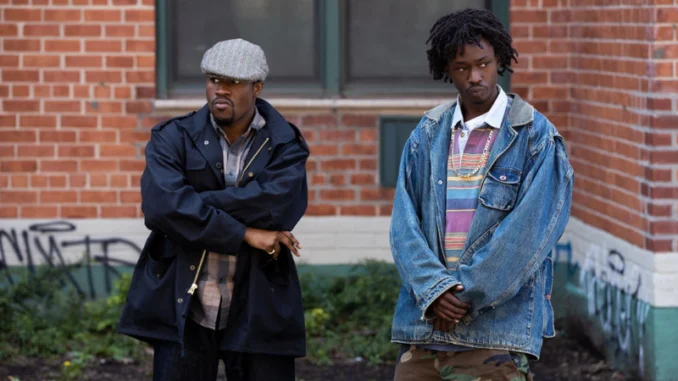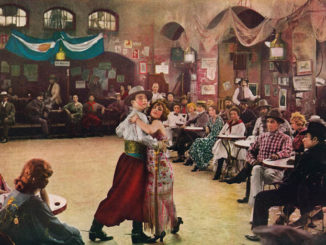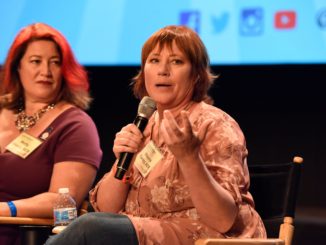
By Patrick Z. McGavin
“I knew I wanted to work in movies since I was 8 years old,” said Marc Wiltshire, the Montreal-born picture editor.
Since studying at NYU’s Tisch School of theArts Graduate Film Department, Wiltshire has lived out his dreams working in a range of television and film projects.
He has cut three episodes of the third season of the Hulu series, “Wu-Tang: An American Saga,” about the formation and rise of the generational hip-hip group, Wu-Tang Clan.
Wiltshire talked about his experiences working with the group’s de facto leader The RZA, who wrote and directed the season-finale that premiered in late March.
CineMontage: What is the dynamic of coming into an existing show with its own established culture?
Marc Wiltshire: This is the third season. Usually a TV show more or less follows a similar style and pattern. On this show they were always doing cool, interesting, fantastical elements in certain episodes, like the pilot had an animated sequence like “Fritz the Cat” (1972).
At its core, the first and second seasons were pretty similar. It was about these guys hustling and trying to get out of their circumstances and make it in the music industry. At the end of season two, they released their first big hit.That was the cliffhanger. When I came for season three, they were now in New York as one of the big hip-hop crews. Tonally it was already a very different shift from the second season. That helped me because it allowed me to make it different on purpose. I didn’t have to try to follow a specific formula or any kind of stylistic things that were done earlier.
At the same time, it was so different and I had to make sure to keep the DNA of the show alive in the third season, and not make it feel like it’s an entirely different show. That was a delicate balancing act of keeping the characters the way they are.
CineMontage: What was your research like? Did you immerse yourself in the first 20 episodes, or want to come at it fresh and raw?
Marc Wiltshire: On Wu-Tang, I didn’t have much of a choice in the matter. When I was 11-years old, I was introduced to a mixtape someone brought on the school bus. This kid handed me the tape, and the first thing I heard was Wu-Tang Clan, “Ain’t Nuthing Ta F’ Wit.” I knew immediately, my mother wouldn’t approve, but I was really into this music, and I became addicted.

When this opportunity came about, I was wearing a Wu-Tang t-shirt. In that interview I made it very clear that I was coming in as a fan. I brought that energy. I was familiar not just with their music. I could match certain songs to certain characters. I’d done my research. I read the two RZA books prior to my working on the show. I was very immersed in the whole culture of Wu-Tang of ’90s hip-hop music.
CineMontage: Do you see episodes as individual chapters of a larger book? How do you find the stylistic consistency and coherence?
Marc Wiltshire: I always wanted to try to push the boundaries as much as I could even within the confines of the structure and the style of the show. It was built in that we’d try to do something a little bit different from episode to episode. Unlike a typical TV show, they intentionally would break the form and do something a little different. With episode five, we had a lot of split screens to tell these three different stories of three different members. In episode eight, the whole thing was a homage to all these different movies and different styles from the wipes of “Star Wars” (1976) to the films of (Akira) Kurosawa, with slow paced, samurai-style of filmmaking.
The DNA of each episode was built into their identity. I think that’s something we’re trying to do more and more with TV is not make it feel the same. Most TV shows are trying to push a little bit, and see what we can do with this episode. As editors, we were able to bring a lot of that to the table.
CineMontage: How would you describe your creative collaboration?
Marc Wiltshire: It was the greatest collaboration I’ve ever had working with RZA. He was just so calm and very clear about what he wanted, but also very artistic. I knew him through his books and through his work, I understood at the core what he was going for artistically. And it was just a very good relationship. I mean, he’d have maybe five minutes for a conversation and then he’s going back on set. But during that time, he would just lay out the foundational ideas. “These are the kinds of references we’re using for this scene,” and then he’d just sort of let me do my thing. And I could just sort of put it together the way I felt.
Nine times out of 10, it was in the pocket, and the other times, he said, “We have to rethink this.” It was almost like talking in codes. He’d say, “This is the feeling we’re trying to get. This is the vibe we’re trying to get. Watch these movies, look at this scene, and do your thing.” It was a lot more liberating than just pushing the buttons for someone’s eyes or specific ideas with him. It was more about, “Let’s see what you can bring to the table and then we will play with that.”
CineMontage: That 48-minute format strikes a weird balance, not quite a feature, but longer than a typical television program.
Marc Wiltshire: That was the funniest thing about working RZA. When we had our first conversation, he said, “Forget everything you know about editing TV, because we’re not going to do that. We’re going to push the studio back. They’re going to tell us to cut it down. But we’re going to make something as long as we can get away with.”
My first editor’s cut was 72 minutes. He watched it, and said, “You’ve got to make it longer. I am not seeing it yet.” He made me milk every moment, and we made this 90-minute cut. From there we had the broad picture, and now we can start shaping this and bringing it down. Ultimately I think the best version of what we locked was the 65-minute cut. Getting there, we had to figure out how to make a movie for a TV schedule and TV show. The way he wrote it was hard to cut massive scenes. Everything connected. The studio was very accommodating. They knew they were going to get something long, because the script was like 65 pages. We got to be free, let it loose and play it long.
CineMontage: Did you talk about rhythm and pace and how you wanted the shows to flow?
Marc Wiltshire: Definitely, and that changed from episode to episode. One of the stories of episode five is the two-year old son getting shot. We are trying to figure out what to do about it, like a suspense action scene with revenge elements going on. One of the other stories is a little bit funnier. He’s producing these beats, and so there’s this musical element. Each of these storylines shifted, and therefore the pacing had to shift. The music scene we tried a little bit faster, the action scene we tried to hold the tension so the audience really feels it.
In the RZA-directed episode, every new character that we meet along the yellow brick road is just like a whole new thing. We have five music videos, and action sequences, but there are also some moments of contemplation. It was also very clear what mode we should be in at any given point in any given scene. Each scene feels like a short film, and then we are on the next adventure.
CineMontage: Is your own theory or style closer to the idea of the invisible cutting rhythm, or more active and pronounced cutting where every cut is explicit or knowing?
Marc Wiltshire: I think it’s a combination. I think it’s really hard to have one approach. Most of the time, with shows like these, we want it to seem seamless. We just don’t want people to be distracted. But then when you pop into a 90s-style music video, it is kind of the opposite intention. You want people to be feeling the energy. It has to be wild, it has to be kinetic, and very much like an acknowledgment that we are cutting all over the place. I tried to listen to the script of the story as a guide of how subtle we should be, or how we should really be pushing the visual storytelling.
CineMontage: What role does improvisation or experimentation play?
Marc Wiltshire: A little less on the earlier episodes. Due to the nature of the creative environment of Wu-Tang, there was a lot of collaboration. Nefertite Nguvu, the director of episode 305, called me early on in pre-production to talk through how do you want to do these split screens. She included me in that process early on to discuss our framing and how we are going to execute that at different points in the story and where we want the people to be.
CineMontage: Growing up in Montreal, were you divided by the Quebecois and English-Canadian sensibility?
Marc Wiltshire: English was my first language. My mom was French-Canadian, but she didn’t speak French to me until I was older. My relatives on her side don’t really speak English, so I realized I had to learn French. I went to French immersion school for elementary and high school.
I am French-Canadian. No matter how long I have been in Los Angeles, I feel this deep connection to Montreal. I am teaching my daughter French, and making sure the French stays alive in our roots. It wasn’t really until I started making films that I was introduced to French New Wave films by Jean-Luc Godard and Francois Truffaut.
I still remember the first time I saw “Breathless” (1959). Even though it was not new by then, I had a similar reaction to the people who saw it when it first came out, of “What am I watching?” This is wild, this is weird, how Jean-Paul Belmondo is talking to the camera, and Godard is cutting all over the place, or a gunshot, and the car drives by, and something is missing. It made sense in my brain.
That got me excited about editing because you could get away with anything. You can just choose what parts to show, or what not to, and you have this power. So I think immediately seeing that made me start to go towards editing.
Patrick Z. McGavin is a Chicago-based cultural journalist. He publishes the blog “Shadows and Dreams” at www.patrickzmcgavin.substack.com.





